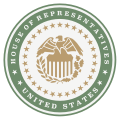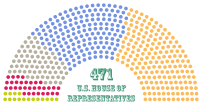United States House of Representatives
| United States | |
| House of Representatives |
| United States House of Representatives | ||||||||||||||||||||||||||||||||||||||||||||||||||||||||||||||||||||||||||||||||||||||||||
|---|---|---|---|---|---|---|---|---|---|---|---|---|---|---|---|---|---|---|---|---|---|---|---|---|---|---|---|---|---|---|---|---|---|---|---|---|---|---|---|---|---|---|---|---|---|---|---|---|---|---|---|---|---|---|---|---|---|---|---|---|---|---|---|---|---|---|---|---|---|---|---|---|---|---|---|---|---|---|---|---|---|---|---|---|---|---|---|---|---|---|
| 123rd United States Congress | ||||||||||||||||||||||||||||||||||||||||||||||||||||||||||||||||||||||||||||||||||||||||||

| ||||||||||||||||||||||||||||||||||||||||||||||||||||||||||||||||||||||||||||||||||||||||||
| Type | ||||||||||||||||||||||||||||||||||||||||||||||||||||||||||||||||||||||||||||||||||||||||||
| Type | Lower house | |||||||||||||||||||||||||||||||||||||||||||||||||||||||||||||||||||||||||||||||||||||||||
| History | ||||||||||||||||||||||||||||||||||||||||||||||||||||||||||||||||||||||||||||||||||||||||||
| Founded |
| |||||||||||||||||||||||||||||||||||||||||||||||||||||||||||||||||||||||||||||||||||||||||
| Preceded by | Assumed some jurisdiction from the Legislatures of:
| |||||||||||||||||||||||||||||||||||||||||||||||||||||||||||||||||||||||||||||||||||||||||
| Current session | ||||||||||||||||||||||||||||||||||||||||||||||||||||||||||||||||||||||||||||||||||||||||||
| Next session starts | 3 January 1735 | |||||||||||||||||||||||||||||||||||||||||||||||||||||||||||||||||||||||||||||||||||||||||
| Leadership | ||||||||||||||||||||||||||||||||||||||||||||||||||||||||||||||||||||||||||||||||||||||||||
| Speaker of the House |
Andy Biggs (L) Since 20 March 1735 | |||||||||||||||||||||||||||||||||||||||||||||||||||||||||||||||||||||||||||||||||||||||||
| Speaker pro Tempore |
Kimble Hookstraten (F) Since 3 January 1735 | |||||||||||||||||||||||||||||||||||||||||||||||||||||||||||||||||||||||||||||||||||||||||
| Structure | ||||||||||||||||||||||||||||||||||||||||||||||||||||||||||||||||||||||||||||||||||||||||||
| Membership | ||||||||||||||||||||||||||||||||||||||||||||||||||||||||||||||||||||||||||||||||||||||||||
House of Representatives | ||||||||||||||||||||||||||||||||||||||||||||||||||||||||||||||||||||||||||||||||||||||||||
| Political groups |
| |||||||||||||||||||||||||||||||||||||||||||||||||||||||||||||||||||||||||||||||||||||||||
| Term | 2 years | |||||||||||||||||||||||||||||||||||||||||||||||||||||||||||||||||||||||||||||||||||||||||
| Term limits | Varies by State | |||||||||||||||||||||||||||||||||||||||||||||||||||||||||||||||||||||||||||||||||||||||||
| Salary | $45,000 per annum | |||||||||||||||||||||||||||||||||||||||||||||||||||||||||||||||||||||||||||||||||||||||||
| Elections | ||||||||||||||||||||||||||||||||||||||||||||||||||||||||||||||||||||||||||||||||||||||||||
| Voting system | FPTP | |||||||||||||||||||||||||||||||||||||||||||||||||||||||||||||||||||||||||||||||||||||||||
| Last election | 4 March 1735 | |||||||||||||||||||||||||||||||||||||||||||||||||||||||||||||||||||||||||||||||||||||||||
| Next election | 4 November 1736 | |||||||||||||||||||||||||||||||||||||||||||||||||||||||||||||||||||||||||||||||||||||||||
| Meeting place | ||||||||||||||||||||||||||||||||||||||||||||||||||||||||||||||||||||||||||||||||||||||||||

| ||||||||||||||||||||||||||||||||||||||||||||||||||||||||||||||||||||||||||||||||||||||||||
| Hall of Representatives United States Capitol 1800 WEST CAPITOL STREET FŒDERAL CAPITAL TERRITORY | ||||||||||||||||||||||||||||||||||||||||||||||||||||||||||||||||||||||||||||||||||||||||||
| Website | ||||||||||||||||||||||||||||||||||||||||||||||||||||||||||||||||||||||||||||||||||||||||||
| link://house.usna | ||||||||||||||||||||||||||||||||||||||||||||||||||||||||||||||||||||||||||||||||||||||||||
The United States House of Representatives is the lower House of the United States Congress, which along with the Senate composes the Federal Legislature of the United States.
The Composition and Powers of the House are established by Article II-B of the 1730 U.S. Constitution. The House is composed of Representatives who sit in congressional Districts which are allocated to each of the thirty States on a basis of Population as measured by the U.S. Census, with each District entitled to a single Representative. Since its inception in 1489, all Representatives are directly elected. The total number of voting Representatives is fixed by Law at 471. As of the 1730 Census, the largest delegation is that of Texas, with NUM Representatives.
The House, together with the Senate, is charged with the passage of federal Legislation, known as Bills, are sent to the Governor-General (for Bills passed under Article II-B, section 8, subsection A) or the Governor-General acting by and with the Advice of the United States Federal Council (for Bills passed under Article II-B, section 8, subsection B) for their approval or rejection. No Bill can be passed without the consent of both the Senate and House of Representatives. If the Bill is approved, it becomes Law ninety Days after the Congress adjourns sine die. If the Bill is rejected, it is sent, together with the Objections, to the House of Congress from which it originated, which then may proceed to reconsider it; and if two-thirds of the total Number of Members of that House approves of the Bill, it is sent, together with the Objections to the other House, which then may proceed to reconsider it; and if two-thirds of the total Number of Members of that House approves the Bill, it becomes Law ninety Days after the adjournment sine die of the Congress, the objections and disapproval of the Governor-General or Federal Council, as the case may be, notwithstanding. In addition to this basic power, the House has certain exclusive powers which include the power to initiate all bills related to revenue (but not appropriation, which must originate in the Senate), the impeachment of federal officers, who are sent to trial in the Senate, and in cases wherein no candidate receives a majority of electors for Governor-General, the duty falls upon the House to elect one of the top three recipients of electors for that office, with one vote given to each State delegation for that purpose.
The presiding Officer is the Speaker of the United States House of Representatives, who is elected by the Representatives and is therefore traditionally the leader of the controlling party. He or she and other floor Leaders are chosen by the Republican Caucus (consisting of the Federalist, Liberal, and Independent members of the House of Representatives) or the Progressive Conference (Consisting entirely of the Progressive members of the House), depending on whichever party has more voting members. The House meets in the south wing of the United States Capitol.
History[edit | edit source]
XXXX
Voting[edit | edit source]
XXXX
Representatives[edit | edit source]
XXXX
Qualifications[edit | edit source]
XXXX
Current composition[edit | edit source]
XXX
Officers[edit | edit source]
XXXX
Procedure[edit | edit source]
XXXX
Committees[edit | edit source]
XXXX
Chamber and symbols[edit | edit source]
XXXX
House office buildings[edit | edit source]
XXXX
Relationship with the executive[edit | edit source]
XXXX
Criticism[edit | edit source]
XXXX
See also[edit | edit source]
- United States Congress
- United States Senate
- State house of representatives (United States)
- List of legislative lower houses
